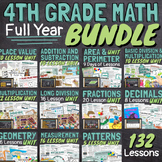Equivalent Fractions Pizza Swap Hands On Math Activity with Concrete Modeling
- PDF
What educators are saying
Also included in
- This 4th grade fractions math unit includes 20 easy to teach lessons that reinforce and review 3rd grade standards (CCSS) and introduce fourth grade standards (common core aligned). Skills taught include: identifying and naming fractionsdrawing fractions using pie models and bar modelsidentifying anPrice $37.50Original Price $62.50Save $25.00
- This year long fourth grade math bundle includes 132 math lessons spanning 11 different units. All lessons are common core aligned and cover all CCSS standards required for 4th grade math!Begin with each unit guide (these are free and linked below!). The lesson plans will walk you through each unitPrice $156.80Original Price $392.00Save $235.20
Description
This hands on math activity is a great way to build conceptual understanding of equivalent fractions and comparing fractions using concrete modeling. Students will have so much fun, they won't even realize they're learning! It's easy to assess understanding of equivalent fractions with a quick look at each student's final pizza.
This resource includes:
- teacher directions
- student directions with photos of each step
- handout of pizza topping ideas and symbols
- 6 pizza templates - halves, thirds, fourths, sixths, eighths, and twelfths
- a scoring rubric
- a black and white version to accommodate black and white printing
To complete the activity students will:
- draw and color toppings on their pizzas and then cut out the pieces
- trade pieces of their pizza for equivalent amounts of their classmates' pizzas (for example, a student can trade a 1/3 sized piece of pizza for two 1/6 sized pieces)
- re-assemble their pizzas - if they end up with an entire pizza, then they swapped correctly!
- write a fraction to represent each type of pizza they ended up with
To differentiate:
6 different fractions are included - halves, thirds, fourths, sixths, eighths, and twelfths. I give lower level students halves, thirds, and fourths and save the sixths, eighths and twelfths for higher level students.
Please follow my store here for more great resources!
You can also find me on Facebook, Instagram, and lafountaineofknowledge.com where you'll discover ideas, inspiration, and plenty of freebies! Or join my email list to get my monthly newsletter with exclusive FREE resources you can't get anywhere else!
Want free money to spend on Teachers Pay Teachers? Rate this product to earn some TpT credit! Leaving feedback helps us both out and takes less than a minute! Your support makes it possible for me to continue making and sharing great resources! Thank you!
Click for more math crafts!
Credits: Clipart by The Cher Room on TpT, used with permission. Cover photo sourced via Pixabay and used with permission. All other photographs and graphics were created by Shea LaFountaine of LaFountaine of Knowledge. Fonts used include: Knewave by Tyler Finck, Pangolin by Kevin Burke, and Londrina Solid by Marcelo Magalhães. All fonts were used with permission under open source licenses.







